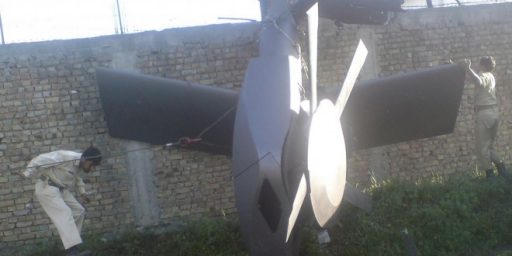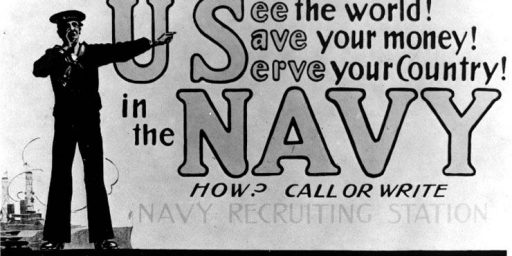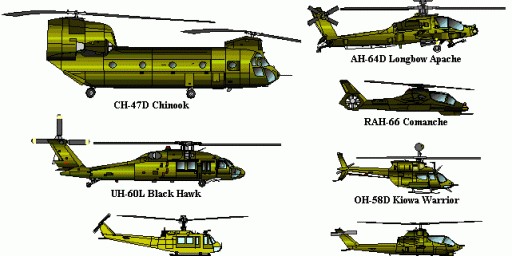Marine One Revamp Overbudget, Behind Schedule
Enhanced presidential helicopters ordered six years ago have not yet been delivered and they will cost more than twice the winning bid, WaPo’s Peter Baker reports on page 1.
A year after Sept. 11, 2001, the White House set out to build a fleet of state-of-the-art Marine One helicopters for the al-Qaeda age that would be safer, more powerful and more reliable than the iconic white-topped aircraft that have landed on the South Lawn for decades. But the al-Qaeda age has met the military acquisition process. Six years later, the cost of the new helicopters has nearly doubled, production has fallen behind schedule, and the bulk of the program has been put on hold while the government tries to figure out how to salvage it.
While one would think the procurement of helicopters designed to ensure the safety and functionality of the president of the United States would be fast-tracked, it’s hard to be shocked by this. The idiocy of the cost-plus bidding system virtually guarantees that the price will balloon and the lack of competition or consequences for failure surely doesn’t incentivize a sense of urgency.
Still, the specifics are staggering.
The Pentagon confirmed this month that the cost of the fleet of 28 new super-sophisticated helicopters has jumped from $6.1 billion when the contract was signed in 2005 to $11.2 billion today. Outfitted with cutting-edge communications equipment, antimissile defenses and hardened hulls, each of the VH-71 helicopters, to be dubbed Marine One whenever the president is onboard, will cost $400 million — more than the most recent Boeing 747 jetliner outfitted to serve as Air Force One when it was delivered in 1990, even when adjusted for inflation.
Nor, incidentally, is the contractor alone to blame. The combination of a spare-no-expenses approach and an expanding wish list has caused many of the problems.
The specifications of the new craft remain largely secret, but some details have leaked into trade publications or have been disclosed in congressional briefings. The 64-foot-long helicopters must carry 14 passengers and thousands of pounds of additional equipment while being able to fly farther without refueling than existing Marine One choppers can. They must be able to jam seeking devices, fend off incoming missiles and resist some of the electromagnetic effects of a nuclear blast.
They also must have videoconferencing and encrypted communications gear to allow the president to instantly reach advisers, military officers and foreign leaders. Although the president typically spends only short periods of time aboard the White House helicopters, at times the president can be onboard for longer distances. In a crisis, the White House says, minutes can make a difference, so a president should have the full capacity to act no matter where he or she is. In theory, a commander in chief should even be able to order a nuclear strike from the helicopter.
[…]
“The Navy and industry team did not clearly realize the full implications of the White House requirements,” John J. Young Jr., the undersecretary of defense for acquisition, said in a written response to questions. To meet those requirements and retrofit a commercial aircraft to Navy standards, he said, “the Navy and industry teams are having to complete substantial redesign” of the helicopter. He added that “this redesign work is driving significant cost growth into the program.”
[…]
The first five helicopters are due in 2010, a year behind schedule, although the White House made compromises on the requirements to cut costs and speed delivery. Twenty-three more-sophisticated versions are to follow, at which point the current fleet and the first five craft would be retired. But the most recent target date of 2015 for these additional choppers has slipped to an unknown date.
The problems with the second batch have prompted the Pentagon to issue a stop-work order until it determines what to do and Congress provides more money. The Pentagon conducted a review of the project and considered 35 alternatives, but “none of these options meet the full set of White House requirements,” Young said.
This is interesting, too, simply because most people think “Marine One” refers to a single aircraft:
Many of the White House helicopters have been in service since that era. The current fleet includes 19 aircraft — 11 Sikorsky VH-3D Sea Kings and eight VH-60N Black Hawks — and the oldest have flown presidents for 33 years.
The squadron also serves the vice president, defense secretary, Navy secretary, visiting heads of state and other officials. So many helicopters are needed because the president typically travels with two or more when he flies, with the extras ferrying staff and Secret Service, serving as backups and playing decoy. When a president makes multiple stops, additional sets of helicopters must be airlifted to his next destinations.
Frankly, I’m not sure what the justification is for giving undersecretaries access to a presidential-caliber helicopter. If nothing else, it’s hard to argue that the SECNAV has more pressing needs than his counterparts in the other Services. One could argue, too, that the decoys don’t need the same level of technology as the real McCoy. On the other hand, there is a need for redundancy and one would hate to have a visiting head of state go down in one of our helicopters and have it come out that they were flying on anything but our best.





No, but in the fine tradition of DoD bureaucracy, “I own ’em, so I get to use ’em.”
I say build one for the Pres and Vice Pres and put everyone else on Robinson R44’s. Including Visiting Dignitaries!
When POTUS travels by helicopter overseas, he travels on Marine One. Days before his arrival, three or more helos are flown in in C5s to be staged and ready to go. If he’s on a multi-stop trip, then it’s multi-based helicopters, though leap-frogging is practiced where possible.
Weeks before an overseas visit, pilots of both Air Force One and Marine One fly into the locations to scope out the terrain, runways, weather, ATC, etc. They try to iron out differences between local practice and POTUS norms where possible. They do hold veto power over whether or not POTUS will fly into/out of/through particular areas.
I recall one Clinton visit to N. Ireland where the weather was so bad that Marine One pilots suggested that ground transportation be used instead of flying between Belfast and Londonderry.
It’s cheaper to build 23 to the same spec, then to build 23 of different specs. And having the decoy based on a different spec opens the possibility of determining which is carrying the President based on the helicopter itself, which undermines the point of using a decoy.
Funny how discussions of military procurement never get around to the FAR. Start there if you really want to understand why overruns and schedule delays exist throughout all defense procurements.
Defense Contractors certainly make money, but not as much as everyone seems to think. Their margins are low, as befits any industry whose risk is capped, but then the government generally doesn’t reward risk takers.